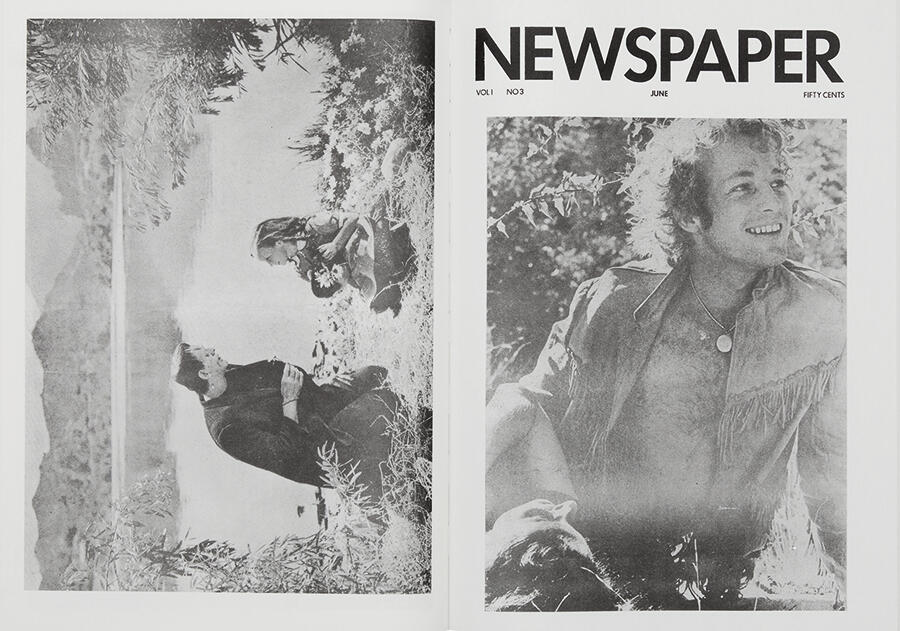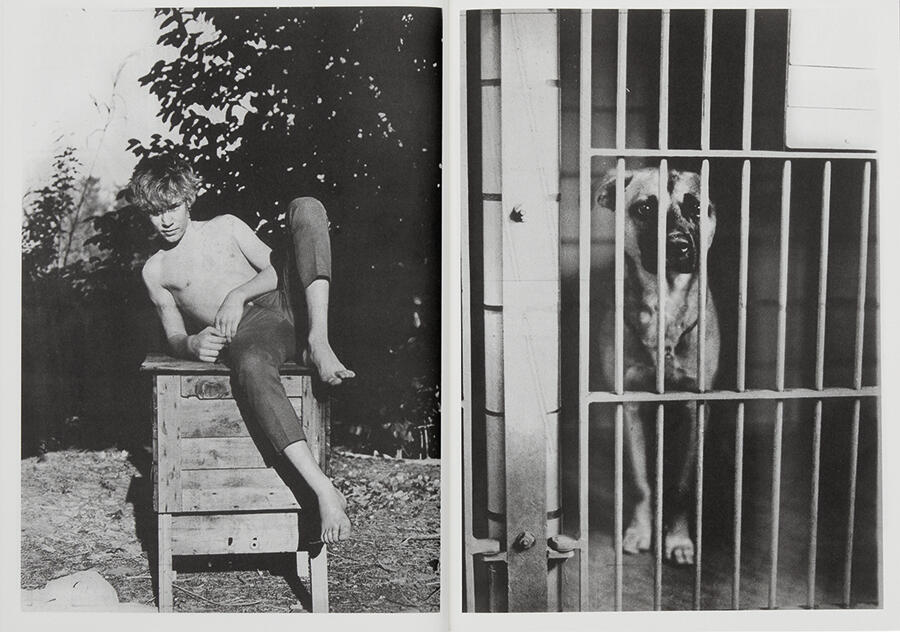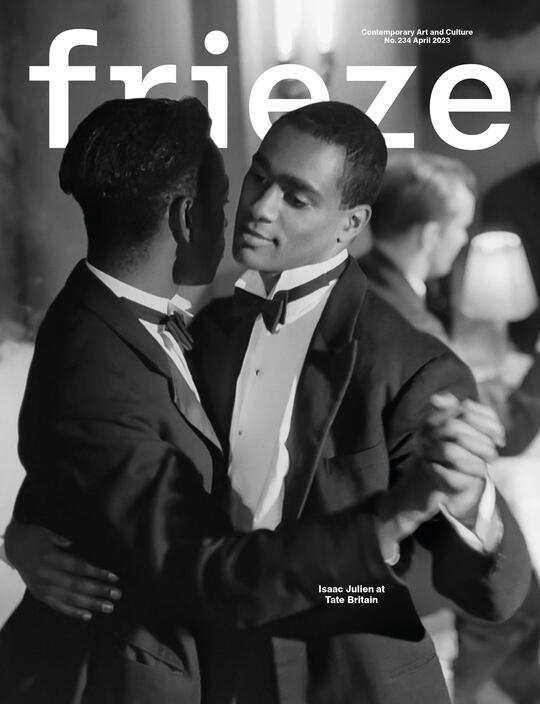Peter Hujar and Steven Lawrence's ‘Newspaper’ Demands to be Seen and Not Read
How the artists used their underground photographic magazine to map New York’s mid-century myths
How the artists used their underground photographic magazine to map New York’s mid-century myths

Steve Lawrence first pops up in New York in the 9 June 1966 edition of The Village Voice – in a short item about four young friends who plan to start a nightclub at Bonnie’s Stonewall Inn on Christopher Street, recently gutted by fire. (‘Fat Tony’ Lauria of the Genovese crime family will beat them to it.) That same year, Lawrence appears in a series of group portraits by photographer Peter Hujar. He’s a head taller than his companions, who include artists Eva Hesse, Marisol, Paul Thek and writer Frederic Tuten. In one image from the series, Lawrence stands at the edge of the group, like a giant bookend. He and Hujar are romantically involved and live together in an apartment on Second Avenue, in the East Village. Lawrence holds a mirror to the camera. Hujar beams in the reflection.

Lawrence can be spotted in photos taken by Hujar on Fire Island and in Manhattan around the same time. In 1967, he’s caught on film again in the garden of a rambling mansion in New Jersey, an extra during the chaotic production of Ciao! Manhattan, John Palmer’s movie about Edie Sedgwick. (It was not released until 1972.) Lawrence is wearing alien fancy dress designed by Betsey Johnson, leered at by a carved gargoyle.
Then you will see him in May 1969, in photographs taken at Andy Warhol’s Factory at 33 Union Square West. (It’s almost a year to the day after Valerie Solanas walked out of the elevator there and shot Warhol.) Lawrence shows off Newspaper, a broadsheet he’s publishing. Warhol and Factory lieutenant Gerard Malanga admire copies of issue two but, confusingly, it’s the publication’s fifth edition: the first two had no title and the third was named Ark; Newspaper only began to appear on the masthead of the fourth.

Newspaper has no words, only images. This edition includes portraits by Sheyla Baykal, Hujar and Jack Mitchell, as well as a collage by Edwin Klein and Thek. It includes spreads made by Lawrence that he calls ‘environments’ – found images, pictures ripped from the news, movies, nature photography. It carries a couple of gallery advertisements, including one for Robert Rauschenberg at Leo Castelli. Cover price is 50 cents, and there’s a number for booking adverts. It’s black and white and produced in a large, foldout format – 86 x 58 cm – the same dimensions as Warhol’s Interview, which launches at the end of 1969. On the cover is a photo by Ruspoli Rodriguez, who designed the rainbow-coloured poster for the musical Hair (1967) the previous year. The image shows a beautiful young man, naked, his arms outstretched, one of them caught at an angle that covers his crotch and covers Lawrence from obscenity laws.
In New York’s mid-century myths – those written at the Hotel Chelsea and photographed at Max’s Kansas City – there’s always someone in the middle ground, pictured to one side of the action. A person neither in with the in-crowd, nor fully outside the circles of cool, but still shy of a threshold that, decades later, might trigger enquiries from biographers and filmmakers. These are names registered only in footnotes buried at the back of out-of-print books, or in memories now interred with the dead. They inhabit the periphery for a few years, then fade from view. You wonder who brought them to the party, where life took them next. Lawrence is one of them.

What order we can impose on his story and on that of Newspaper – the thread that tethers him to Hujar, to New York scenes of the period – is thanks to the detective work of art historian Marcelo Gabriel Yáñez. In 2015, Yáñez worked as an archivist for Danny Fields, the writer, music publicist and Warhol associate. He discovered bundles of Newspaper in a closet, the paper crisped with age, crumbling to the touch. Fields could remember little about the publication; copies simply turned up at The Factory. Yáñez suspected there was a story to be unearthed, and so began the painstaking process of researching the publication’s history and piecing together fragments of Lawrence’s life from archives and interviews. Seven years on, the complete 14-issue run of Newspaper has been restored by Rick Myers and photographed by David Vu. Along with a timeline of Newspaper written by Yáñez, these have now been collected in one volume, published this spring by Primary Information.
Newspaper was Lawrence’s initiative, but it’s hard to divorce it from Hujar’s influence. He was never a named editor, but his work appears throughout most of Newspaper’s run, even after his relationship with Lawrence ended. The magazine features portraits by Hujar, including Tuli Kupferberg of The Fugs; the blind composer Moondog; and members of The Cockettes, the San Francisco acid cabaret troupe. These photographs indicate the growing importance of performance in Hujar’s evolving classicism, his interest in rock music and downtown cabaret. It’s as if Hujar is feeling out possible directions in which to travel. The Ark-titled issue, dated early 1969, features two photographs taken in the catacombs of Palermo in 1963. Issue five, October 1969, includes a plain still life of an armchair. The same edition features a centrefold of Candy Darling reclining on a cloud, her body a collaged composite of other people’s; it’s a work by Richard Bernstein but it’s hard to see without thinking of Hujar’s famous 1974 portrait of Darling lying on her deathbed. Even the occasional, uncredited animal photograph – a poodle, a fluffy cat – seems to echo Hujar’s interest in animal portraiture.

The publication serves as a map of Hujar’s networks. There are contributions from artists who predate Lawrence’s arrival in New York, friendships that began in the 1950s, such as with Thek and Joseph Raffael. Ray Johnson, later photographed by Hujar in 1975, makes a couple of appearances. (This connection makes it tempting, if a stretch, to place Newspaper in the context of mail art and other attempts to sidestep the gallery system.) Issue one includes a pair of Billy Name photos taken at the Factory of Brigid Berlin, Ondine, International Velvet and Viva. Hujar had known Warhol since the early 1960s. (He held so still during his Factory Screen Test, noted Callie Angell in her 2006 catalogue raisonné of Warhol’s films, that he was referred to as ‘the boy that never blinked’.)
Newspaper is also an oblique account of Hujar’s commercial photography. Images of Iggy & The Stooges and Moondog, for instance, were originally advertising commissions. (Yáñez tells me that the music advertising in Newspaper came through Fields and points out a connection to Rolling Stone founder Jann Wenner, whose Straight Arrow Press is credited as the printer in later issues.) Significantly, Newspaper features contributions from Diane Arbus and Richard Avedon. Hujar had worked as an assistant to photographer Harold Krieger in the mid-1960s. In 1966, he was introduced to Ruth Ansel and Bea Feitler, art directors of Harper’s Bazaar, for whom he would shoot commissions for several years. In 1967, he was accepted into a photography masterclass run by Avedon and Marvin Israel, a former art director of Harper’s. Guest teachers included Arbus, Hiro, Danny Lyon and Lucas Samaras. It was a pivotal moment for Hujar.

Philip Gefter writes in his 2020 Avedon biography, What Becomes a Legend Most, that ‘one overarching question’ the masterclass posed ‘had to do with whether the subject of a photograph was less important than how the subject was seen’. It’s a question that Newspaper seems to ask, too. When viewed through the museological lens of our present – a dreary hindsight which finds conceptual intent in what was originally ad hoc – Newspaper might be filed under the labels of ‘artists publications’ and the dematerialized artwork. (In 1970, Kynaston McShine would include Newspaper in his landmark conceptual art exhibition ‘Information’ at the Museum of Modern Art in New York. Each issue was unfolded and attached to the wall, accompanied by polaroids taken by Lawrence documenting it in the hands of passersby in Manhattan.) But Yáñez tells me that people would tear from Newspaper images they liked and pin them to the wall. It was used like a magazine, not archived like a relic.
The late 1960s saw a great flowering of the alternative press, publications addressing music, ecology, politics and sex. Newspaper was distributed informally by mail and in person by Lawrence at bars or events, just as many underground papers were. The absence of commentary, the enigmatic juxtaposition of imagery, the eroticism in its pages – both literally and figuratively – would seem to affirm this underground spirit. Yet, Newspaper also appears to echo changes in commercial publishing, too. The relationship between type and photography was being rethought throughout the decade, spurred by competition from broadcast media. In the fashion press, clothing designers appeared alongside the latest avant-garde artists, authors and performers. Everyone was in conversation with each other on those pages. In Newspaper’s spreads too, it’s just that those exchanges were conducted in the codes of downtown New York, harder to decipher.

As Arbus once said in a 1959 letter to Robert Benton: ‘Maybe the comment has to be implicit in the pictures.’ Gay Talese – one of the boldface names in new journalism, which was reshaping American magazines of the 1960s and ’70s – stated in a 1970 roundtable discussion in Writer’s Digest that he was ‘not so interested in what [his subjects] did and said as what [they] thought’. Looking at Newspaper is like looking at print media’s subconscious, at what it’s thinking, not what it’s doing. The newspaper, traditionally conceived as a medium of trust, is revealed to be a medium of desire.
The final issue of Newspaper is published in 1971. Lawrence, in drag, hands it out at the Anderson Theater, near his home on Second Avenue, in November of that year, on the night that The Cockettes bomb spectacularly in front of a celebrity crowd. He shifts between Manhattan and Fire Island, relaunching his publication in 1975 as Picture Newspaper. The Spring 1976 issue of FILE Megazine reports that ‘MIGUEL SANCHEZ, DAVID SMITH and STEVE LAWRENCE of the very up-tempo uptown Picture Newspaper, one of the world’s few newsprint glossies, were still fuming over DAVID BOWIE lifting the Picture Newspaper format and concept for his North American tour program.’ Sightings of Lawrence become infrequent. He suffers mental health problems. In the early 1980s, he’s thought to be working in advertising in Dallas-Fort Worth. In 1983, Lawrence dies, aged 38, causes unclear. Hujar dies of complications from HIV/AIDS in 1987. Meanwhile, Newspaper sits bundled up in closets, stuffed in the back of museum files, yellowing, disintegrating, waiting to be delivered.

Writer Vince Aletti – then a music journalist – met Hujar in 1969. Aletti had been writing for underground paper Rat and working at Peace Eye Bookstore, run by Ed Sanders (like Kupferberg, a member of The Fugs). He’d also picked up the first few issues of Newspaper. ‘It felt like it was being published just for me. All pictures (mostly photographs), no words – the rawest, purest sort of media […] I remember how exciting it was when it was included in McShine’s ‘Information’ exhibition at MoMA. It was like the underground press turned into an art project.’
Since the mid-1960s, Aletti has been collecting printed images. Tear-sheets, photos pulled from magazines and newspapers, movie and music publicity shots, postcards, exhibition invitations, photobooth snaps. Half a century later, there must be thousands of them – he doesn’t care to count. They’re stored in files and boxes in his apartment, some are pinned on the wall, but they mostly live in a drawer, which serves as a regularly replenished resource, as reminders, inspiration and provocation for his writing and curating work. ‘Magazines come in waves,’ he writes in the introduction to ISSUES: A History of Photography in Fashion Magazines (2019), ‘washing up as stacks around my apartment: a year in pictures, a decade in print, a lifetime of images, both fleeting and indelible.’

SPBH Editions in Milan recently published The Drawer (2022), a large-format book of pictures from Aletti’s collection – no commentary, only images, just like Newspaper. The book was made in one afternoon. The drawer was removed from its cabinet and placed on the floor. Aletti arranged the images on the top layer, working instinctively, taking no more than a few minutes to create a composition, which was shot by photographer Anushila Shaw. Then Aletti would move on to the next layer down, the next arrangement. In total, 67 spreads made the final edit. ‘It was as quick and spontaneous as possible. I didn’t want to overthink it,’ Aletti tells me. ‘I didn’t want to worry about what anybody would think.’
Containing images made 50 years ago and photos shot yesterday, The Drawer is thick with desire and dreaming. Desire for men, some naked, others clothed, some muscular, hairy and classically handsome, others wiry and androgynous. For athletes who play throughout the pages, from models in 1950s muscle magazines to modern basketball stars. For artists, too, either in person or through their work, who return throughout The Drawer like musical recapitulations: Jean-Michel Basquiat, The Beatles, Rock Hudson, stars of the Nouvelle Vague, Susan Sontag, Tom of Finland, Warhol, Avedon and Hujar.

Faces and bodies are jammed together in every spread, like a sweaty dance floor. It’s an indirect reminder that Aletti, as well as being a noted photography critic, was one of New York’s finest writers about disco. In the introduction to the Hujar monograph Lost Downtown (2016), Aletti recalls how Hujar ‘saw disco mostly from the sidelines, as a spectacle; I was swooning in the middle of the crowd, lost in music.’ The Drawer gives a vivid feel for these images as physical, printed matter. It makes you want to sift and dig. You can see torn edges, fragments of picture captions, paper browned with age or snow white and new. You can sense weight and thickness. The Drawer encourages whoever holds it to value photographs which can be touched, not just looked at – whether you know what the image is, or who it is by.
This article appeared in frieze issue 234 with the headline ‘Not a Word’
Main image: Vince Aletti, The Drawer, 2022. Courtesy: © Vince Aletti
























